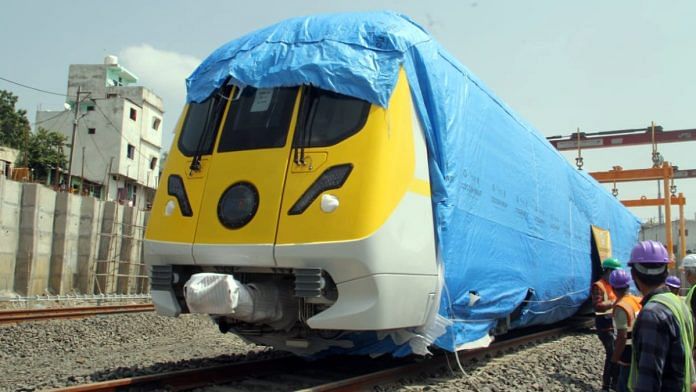New Delhi: The central government is working on a set of guidelines to standardise various components of metro construction in a bid to bring down costs and expedite projects, ThePrint has learnt.
According to senior officials in the Ministry of Housing and Urban Affairs (MoHUA), standardisation of components including rolling stocks, civil engineering etc. will help bring down the cost of construction and reduce estimated time of completion owing to easy availability of components.
Last year, the ministry constituted four committees to standardise four crucial components of metro construction: rolling stock, civic engineering, traction system and electro-mechanical.
While rolling stock refers to carriages, civil engineering includes the layout of metro stations, tunnels and elevated corridors, the traction system is the electrical grid that powers the carriages, and the electro-mechanical is a reference to elevators and escalators etc. installed at metro stations.
The ministry had issued standardisation guidelines for electrical and electromechanical components of metro rail in August 2018.
A senior official told ThePrint that the ministry is “looking into various components of metro rail construction and will come out with specific guidelines soon”.
The aim, the official said, is to “standardise basic components such as size of coaches, seating, capacity of lifts, speed and step width of escalators etc.” to ensure that these components are easily available. “This will not only bring down the cost due to the competitive market but also expedite procurement,” the official added.
A second ministry official concurred, “Each metro corporation coming out with their own specifications while tendering for various components just adds to the cost of the project since a limited number of suppliers can meet the specification. If there are standards for some components, then manufacturers/suppliers know what is the requirement and the components will be readily available. This will save both time and cost.”
Adding that the guidelines will be finalised after detailed consultation with various stakeholders, the official quoted earlier said that the guidelines “will not be binding on the metro corporations”.
According to senior ministry officials, the guidelines regarding the electro-mechanical component are in advanced stages. “It was put up in public domain for stakeholder consultation a few months back. The work on the other three components is going on,” said the first official.
Also Read: States queue up with metro proposals, but housing ministry exercising caution before giving go-ahead
‘Standardisation can be done only to an extent’
This attempt at standardisation of components comes against the backdrop of a number of state governments proposing metro projects for various tier-2 cities.
At present, the operational metro network in India spans around 872 km. Over the past three years, the ministry received 21 proposals from 10 states/UTs for the development of another 462 km. Of these proposals for new metro corridors, two have been approved so far.
While ministry officials maintained that train coaches and some aspects of civil engineering involving designing of stations, traction or electrical supply components can be standardised to a large extent, an expert told ThePrint that, with technological advancements, complete standardisation of metro components may not be possible, adding that new technology must be looked at in order to improve the metro rail system.
“Technology is changing very fast. In capital intensive projects like the metro, we have to constantly look at new technology which can make operations and construction faster and more efficient. Standardisation can be done only to some extent,” said an expert who did not want to be named.
The expert added that the ministry can “share guidelines and best practices with metro corporations to plan better”.
Ministry officials too admitted that guidelines have to be reviewed at regular intervals.
“We came out with the standardised guidelines in 2018 and now the new set of guidelines will be as per the latest developments. Moreover, these are not binding on agencies to follow it,” said a third official.
(Edited by Amrtansh Arora)
Also Read: After axing metro plan, UP govt explores high-speed rail link between Noida & Delhi airports



